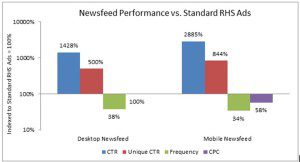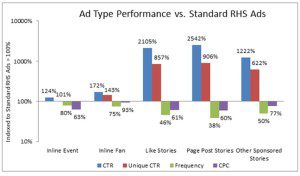 When it comes to variability between desktop and mobile advertising on Facebook, new data from Adobe suggests context and content matter in native ad placement.
When it comes to variability between desktop and mobile advertising on Facebook, new data from Adobe suggests context and content matter in native ad placement.
Desktop newsfeed ads yielded a 14% greater click-through rate than right-hand side ads, according to a recently published study that looked at an aggregate of customer data for cross-channel ad optimization solution Adobe Media Optimizer, which represented 150 billion Facebook ad impressions for 50-plus advertisers.
On mobile devices, newsfeed ad performance was similarly strong compared to RHS ads, generating 28% higher CTRs with 42% lower cost per clicks. Additionally, daily impression frequency was 62% lower for desktop newsfeed ads and 66% lower on mobile.
(Facebook Newsfeed Performance vs. Standard RHS Ads. Source: Adobe)
Although newsfeed ads can struggle with scalability due to tighter controls on insertion and impression frequency than right-hand side ads, there are ways to drive higher performance natively.
“When we’re looking at comparables between news-feed placements and right-hand side placements, what we’re seeing, and, as data’s proving, is your newsfeed placements do drive a lot more success in brand messages,” said Rebecca Kaykas-Wolff, group product marketing manager for Adobe Social Advertising solutions. “Placement, strategically, is important for return on investment from a marketing perspective.”
In terms of performance of varying ad units and despite Facebook’s reduction of more than 50% in its 27 ad formats this summer (See Facebook news release), Kaykas-Wolff noted that measuring performance by varying units will continue to be an important consideration for marketers using Facebook to deploy social ad campaigns.
(Ad Type Performance vs. Standard RHS Ads)
Adobe found “page posts that had the best yield in results were supported by content that was contextually relevant and in that stream of content,” she said. For instance, Inline Event ads (or an event posted on a brand’s page) experienced 24% higher CTRs than standard ads. Similarly, Inline Fan ads yielded 72% more return than standard ads. Sponsored stories, including both “liked” stories and page-post stories, generated similar results with 21 and 25 times higher CTRs than standard ads.
Commenting on Facebook’s move to reduce and eliminate ad formats such as standalone Sponsored Stories, Kaykas-Wolff noted, “It’s always hard for us to comment on Facebook’s strategy, but what I can say is simplification of ad types is always a good thing, especially as you try to find the most compelling units that drive the best business results.”














